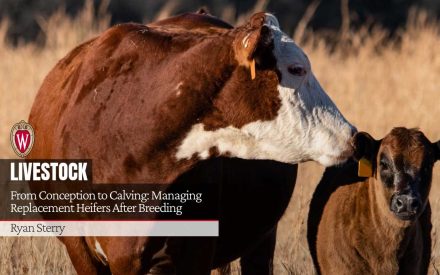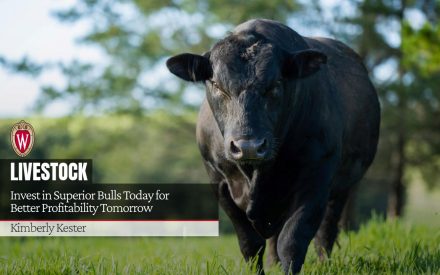When storing forages for your herd there are a range of options available to you from silo bags to bales. There is not a right or wrong choice when choosing a storage option however, improper management of feed in storage will lead to what is known as feed shrink or the loss of feed. Feed shrink can come from the loss of feed through harvest, storage, and feed out. Since feed cost is usually ranked as the highest expense in animal production, reducing shrink in storage will help decrease the cost of production.
Silo Bags
The first thing to consider when trying to reduce feed shrink in silo bags is if you will be able to remove enough feed from the face of the bag to prevent spoilage. In order to prevent oxygen from permeating into the face of bag and causing spoilage at least 12 inches of feed per day needs to be removed. Table 1 can be used as a guide when deciding silo bag size you would need or you may use the Silage Bag Calculator. When feeding out of a bag, only remove enough plastic for a day or two. If too much plastic is removed, feed will be exposed to oxygen which will lead to spoilage.
| Bag Length** | Bag Diameter | |||
| 8 ft | 9 ft | 10 ft | 12 ft | |
| 100 | 27.5 | 33.9 | 40.9 | 55.9 |
| 150 | 44.3 | 54.6 | 66.4 | 92.7 |
| 200 | 60.1 | 75.3 | 91.9 | 129.4 |
| 250 | 76.5 | 96.0 | 117.4 | 166.2 |
| 300 | 92.8 | 116.6 | 143.0 | 202.9 |
Table 1. Capacities of Silage at 13 lbs DM/ft3 (adapted)*
*Adapted from Silage Bag Capacity by Brian J. Holmes
** Actual silage fill used in calculation i.e., if bag is length 100 and diameter is 8 ft actual silage fill is 84 ft
The optimal location for a silo bag is on a concrete pad. This however, is not an option that is always practical for every operation. The second best option is to place the bag on a gravel pad, at minimum though, the surface the bag is on needs to be dry and well drained. Another consideration for the location of the bag is that it is away from trees and brush piles or any other area that is a habitat for rodents and other wildlife that can become pests. This will help reduce damage to the bag as well as reducing the amount of feed pests may consume. If damage does occur, the bag should be repaired immediately to reduce loss from spoilage and pest consumption. The area around the bags should also be kept clean by removing spilled feed and mowing grass and weeds to further discourage pests.
Properly managing a bag during filling will also help minimize shrink. When harvesting corn silage, moisture of the silage should be between 65 – 70% to ensure ideal fermentation conditions. If the silage is wetter than 70%, leaching of silage juices can occur resulting in a loss of nutrients. Proper filling will also pack the bag tightly, limiting the amount of oxygen in the bag. For more information on filing and proper bag management see Focus on Forage: Managing Forage in Silo Bags.
Silage Piles
Many of the same principles when feeding silage out of a bag applies to silage piles such as needing a location with a firm, dry surface with drainage. Similar to determining if you are able to feed enough to keep your silage fresh in a bag, you will need to size your pile by height, width, and length to ensure you are able to remove enough silage from the face to keep the feed from spoiling. Also, only remove as much plastic as needed from the pile. An added challenge for silage piles is covering the pile with plastic. Plastic should be tight across the pile, sealed along the edges, and the plastic should be weighed down over the top of the pile. This helps keep the plastic tight to the pile limiting oxygen from entering the pile. The most frequently used item to weigh silage plastic down are cut tires. The Extension publication A3511 Drive-Over Silage Pile Construction explains in more detail how to size, pack and cover a silage pile.
Large Bales
One of the most popular ways to store forage for beef cattle is in bales. When evaluating storage options for bales, consider if the method of storage will allow for protection against the elements. It is important to limit moisture from entering the bales either from precipitation or from contact with soil. Some options for storage are better than others at preventing shrink but each will have to be evaluated to determine what fits best in your operation. Below is a table listing several options as well as the range of dry matter loss associated with each for large bales. Certainly, covering bales helps reduce loss but there are several ways to accomplish this. The number one storage method is storage under a roof, however, that is not always possible so plastic wraps and sleeves can be utilized as well.
Table 2. Effect of Storage Method on Storage Losses
| Storage Method | Range of Dry Matter Loss (%) |
| Under roof | 2-10 |
| Plastic wrap, on ground | 4-7 |
| Bale sleeve, on ground | 4-8 |
| Covered, rock pad or elevated | 2-17 |
| Uncovered, rock pad or elevated | 3-46 |
| Uncovered, on ground, net wrap | 6-25 |
| Covered, on ground | 4-46 |
| Uncovered, on ground | 5-61 |
Bale shape is another consideration when trying to reduce shrink in storage. Square bales have the advantage of stacking more compactly and saving space; however, round bales allow for water to shed more easily. Depending on your storage situation either bale shape can work for you. There are a few other considerations, such as the orientation of the bales. Bales should be oriented north to south and rows three feet apart to promote faster drying. Similar to the other storage options discussed in this publication, having proper pest management in place and keeping the area around the bales cleaned up will reduce losses. For more information check out the Focus on Forage: Big Bale Storage Losses; how different options stack up.
References
Min, D. 2011. Large round bale storage. MSU Extension https://www.canr.msu.edu/news/large_round_bale_storage
Holmes, B. J. 2012. Silage Bag Capacity Calculator. https://fyi.extension.wisc.edu/forage/files/2014/02/BagSiloCapacity1-31-12.xls
Holmes, B. J. 1999. Silage Bag Capacity. https://fyi.extension.wisc.edu/forage/files/2014/01/SilBagCap.pdf
Roach, J.M. and Kammel, D.W. Drive Over Silage Pile Construction. A3511 https://fyi.extension.wisc.edu/forage/files/2017/03/A3511.pdf
Saxe, C. 2007. Big Bale Storage Losses; how different options stack up. Focus on Forage v 9: No. 1 https://fyi.extension.wisc.edu/forage/files/2014/01/BigBaleStorage-FOF.pdf
Saxe, C. 2007. Managing Forage in Silo Bags. Focus on Forage v 9: No. 2 https://fyi.extension.wisc.edu/forage/files/2014/01/ManageSiloBags-FOF.pdf
Wilcke, B., Cuomo, G., Martinson, K., and Fox C. 2018. Preserving the value of dry stored hay. UMN Extension https://extension.umn.edu/forage-harvest-and-storage/preserving-value-dry-stored-hay#rectangular-bales-1060061
Download Article

 Grazing Practices for Sheep and Flocks - 2020 Small Ruminant Webinar Series
Grazing Practices for Sheep and Flocks - 2020 Small Ruminant Webinar Series Small Ruminant Health - 2020 Small Ruminant Webinar Series
Small Ruminant Health - 2020 Small Ruminant Webinar Series From Conception to Calving: Managing Replacement Heifers After Breeding
From Conception to Calving: Managing Replacement Heifers After Breeding Invest in Superior Bulls Today for Better Profitability Tomorrow
Invest in Superior Bulls Today for Better Profitability Tomorrow


